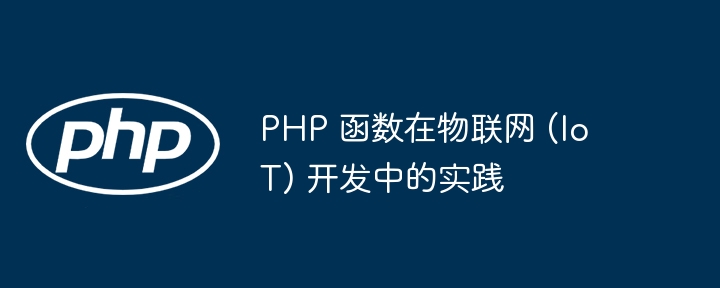
In Internet of Things (IoT) development, PHP provides functions that can be used to connect to IoT devices, send and receive data. Use fsockopen() to connect to the device, fwrite() to send data, and fgets() to receive data. You can also send HTTP requests through the cURL library to control smart devices, such as turning smart light bulbs on or off.

Practice of PHP functions in Internet of Things (IoT) development
Introduction
PHP is a powerful scripting language that is widely used in web development, but it also has great potential in the Internet of Things (IoT) space. PHP provides a set of convenient functions to easily handle communication between IoT devices and servers.
Connecting to IoT devices
To connect to IoT devices, you can use PHP’s fsockopen() function. This function will create a socket connection to the device, allowing you to send and receive data.
$socket = fsockopen("192.168.1.10", 8080);Send data to the device
Once the connection is established, you can use the fwrite() function to send data to the device.
$data = "Hello from PHP!"; fwrite($socket, $data);
Receive data from the device
Similarly, you can use the fgets() function to receive data from the device.
$data = fgets($socket); echo $data; // 输出设备响应
Practical case
Controlling a smart light bulb
Suppose you have an ESP8266 module connected to a smart light bulb. This module can control light bulbs via HTTP requests. You can use PHP to send HTTP requests to control a light bulb.
You can use the cURL library to send HTTP requests:
$curl = curl_init(); curl_setopt_array($curl, array( CURLOPT_URL => "http://192.168.1.20/control", CURLOPT_RETURNTRANSFER => true, CURLOPT_POSTFIELDS => "command=on" )); $response = curl_exec($curl); curl_close($curl);
After executing this code, the smart light bulb will turn on.
The above is the detailed content of PHP functions in practice for Internet of Things (IoT) development. For more information, please follow other related articles on the PHP Chinese website!
 How to open php file
How to open php file
 What are the applications of the Internet of Things?
What are the applications of the Internet of Things?
 How to remove the first few elements of an array in php
How to remove the first few elements of an array in php
 What to do if php deserialization fails
What to do if php deserialization fails
 How to connect php to mssql database
How to connect php to mssql database
 How to connect php to mssql database
How to connect php to mssql database
 How to upload html
How to upload html
 How to solve garbled characters in PHP
How to solve garbled characters in PHP